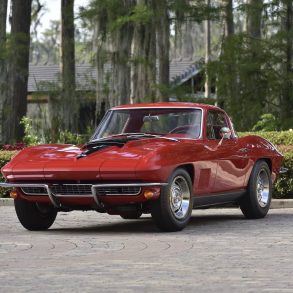
This 1965 Shelby Cobra represents the ultimate specification of the venerable racing 289 Cobra and is one of just six 289 Cobra factory team roadsters constructed to FIA specs for the 1964-1965 US Road Racing Championship (USRRC) series. These became known as the ‘cut down door cars,’ due to the accommodation of widened rear fender wells. Of the six, CSX 2557 is one of two fitted with the dual side pipes on each side of the car as per the Daytona Coupe configuration.
Considered one of the most original of all the famed Shelby Cobra 289 race cars, CSX 2557 boasts an unblemished, extensive race history and is presented in exceptional condition – the result of nearly half a century’s careful preservation, restoration, maintenance and enjoyment. It has been restored to its original Shelby team appearance in Guardsman Blue with White Le Mans stripes.
1964 Shelby 289 Cobra Roadster – CSX 2557
Reproduced on the last page of Mike Shoen’s book, The Cobra-Ferrari Wars, is a hand-annotated typewritten page listing just 42 “Cars Built to Racing Specification.” A legend was built on the successes of those few cars.
Nearly a half century after the first of them was built and more than four decades after the last of them left AC in Thames Ditton and Shelby’s Los Angeles shop, this legend still inspires the admiration and respect that makes the name “Cobra” recognized worldwide. And while many legends are embellished with the passing of time, the Cobra’s iconic status is based on solid fact: the success of a few passionate guys who bested the established powers in U.S. and international road racing on the strength of their ingenuity, persistence, creativity and drive.
Of those 42 “Cars Built to Racing Specifications,” only 29 enjoyed the distinction of being factory team cars, part of Shelby’s continuous efforts from the very first Cobra to discover the weaknesses of the combination of the AC Ace chassis and body with Ford’s lightweight cast iron 260 and 289 cubic inch V8 engines. As shortcomings surfaced – which they did from the very first Cobra built – they were corrected in the next series of team Cobras, then combined with the latest thinking in performance equipment, engine tuning and tires to discover a new round of improvements to be incorporated in the next series of team cars.
A compact organization, with short lines of communication between Shelby in California and AC in England, the changes developed in competition were quickly incorporated in production Cobras, making it easy for the two factories and private owners to convert production cars to competition. It was the sort of continuous improvement that took decades for major carmakers to adopt. It was second nature to Shelby’s competition-focused crew and essential to realize the Cobra’s potential.
It also meant that the later cars were always better than their predecessors. The last of the series, the six “cutback door” 289 factory team roadsters built for the 1964-65 U.S. Road Racing Championship series, were the best of all.
The 1963-65 period saw the glorious culmination of a generation’s evolution of road racing in the years after World War II. Ferrari, Maserati, Porsche, Aston Martin, Alfa Romeo, Jaguar, Lola and Chevrolet fielded factory-backed teams to contest epic contests on purpose built road courses at Monza, Daytona, Goodwood, the Nürburgring, Bridgehampton and Montlhèry; legendary open road circuits at the Targa Florio, Rheims, Le Mans and Spa Francorchamps; the airport circuit at Sebring; and the 8-day trial that made up the Tour de France Auto.
These top marques built models that are today nearly mythical in their allure and performance – GTO, 275P, 250LM, Project 214, Lightweight E-type, Tipo 151, GTZ, 904, Grand Sport – often building specific cars adapted in engine, transmission, suspension, bodywork and even wheelbase to suit the performance characteristics of a specific course, season and race length. In just a small cluster of years in the middle of the Sixties, some of the most famous, desirable and beautiful sports racing and gran turismo automobiles ever built were created and raced.
Carroll Shelby pursued the same development track, creating a series of increasingly specific Cobras in just a few years but basing them on his own concept of marrying a lightweight but – by the standards of the day at least – large displacement American V8 engine with a proven chassis, suspension and bodywork. The concept wasn’t new. Railton had done it in England in the thirties with Hudson drivetrains. Jensen had used Ford V8s, impressing even Edsel Ford with their design, handling and performance. Sydney Allard also was a Ford guy before he adopted the overhead valve V8s from Cadillac and Chrysler.
Shelby’s opportunity arose when Bristol stopped production of its BMW-based two-liter six. AC Cars had employed it with success for extra performance in its Ace roadster, a beautiful little two-seater built on a John Tojeiro-designed chassis with four-wheel independent suspension. Originally built for AC’s ancient (designed by John Weller in 1919) single overhead camshaft two-liter six, the Bristol’s added performance made a consistent winner of the Ace in two-liter competition, and the loss of Bristol power threatened the small manufacturer with extinction. Shelby learned of Ford’s new 260 cubic inch Fairlane V8 and talked Ford out of two of them to create a Cobra proposal. It created a sensation when launched at the New York Auto Show in 1962.
Production followed swiftly, if in small quantities, as did competition. In October 1962 at Riverside, the first steps in Cobra development were undertaken after the car, driven by Bill Krause, failed to finish when a rear hub failed. The first Cobra race win was notched only three months later, also at Riverside, in the hands of Dave MacDonald. As unlikely as it sounded, Shelby set his sights on an FIA Manufacturers Championship and a parade of ever stronger, better handling, more reliable and faster Cobras began to pass through the roster of the Shelby team.
Cobra historians (and for this we defer to the 4th edition “World Registry of Cobras and GT40s”) group the factory team cars into just seven clusters, which culminate in the 1964-65 USRRC Roadsters of which the example offered here, CSX 2557, is one. Specifications merged, consistent with constant evolution in 1963, but the evolution became clearer as the march to the 1965 Manufacturers Championship gathered momentum. The transverse leaf spring independent suspension chassis John Tojeiro designed for the two-liter AC engine in 1953 grew stronger, and its handling and steering became more predictable and setup more flexible to meet the demands of the widely varying circuits and conditions on U.S. road courses, as well as the diverse demands of the FIA’s international schedule.
Engines were based on standard “K-Code” Mustang 289/271 hp powerplants with race prepared lower ends, ported and polished heads with big valves, Cobra intakes with a quartet of Weber downdraft carbs, headers, side outlet exhausts, big oil sumps with baffles and anti-surge doors and oil coolers. The cars got oversize fuel tanks with “Monza” quick release fuel filler caps, Koni shock absorbers, anti-roll bars, stiffened springs, Halibrand center lock magnesium wheels, oversize brakes, brake cooling, differential oil coolers, wider wheels and tires and many more modifications for performance and reliability.
The performance of the little Ford V8 soon overpowered the standard racing tires, and Shelby, with Ford’s support, looked for better rubber. As much as Ford was battling Ferrari and Jaguar for dominance on the track, Goodyear and Firestone were locked in a desperate struggle for supremacy in the “round, black things” that put it all to work. Shelby found its solution first in the “Stock Car Specials” Goodyear built for NASCAR, getting the winged foot technicians to cut a shallow blocky tread pattern on the NASCAR slicks (that soon became slick in competition) that locked the Ford engine’s generous torque to the pavement.
Eventually bigger tires required wider wheels, and by the 1964 FIA season, the narrow AC-derived 289 Cobra body no longer could claim to encompass them within even the most aggressive tacked on flares. The wide hips that would later come to characterize 427-powered Cobras made their debut on a series of 1964 FIA Cobras, and even they were barely able to shelter the 8 ½-inch wide Halibrands and their beefy rubber. The exaggerated rear fenders extended into the door area, which necessitated reshaping the doors to a radically radiused rear edge and inspired the moniker “cutback doors” that has come to characterize these cars, nearly the ultimate in small block competition Cobra development.
The voluptuous fenders, huge air intakes, big wheels and tires foreshadowed the new Cobra II, the 427-powered coil spring suspension Cobras that would soon supplant the first generation. Combining the aggressive appearance of the later 427s with the lighter weight, more responsive chassis and better balance of the small block Cobras, the cutback door Cobras set a standard for aggressive appearance with performance to match which still inspires admiration.
Later in 1964, Shelby completed a series of the ultimate competition 289 Cobras. Essentially constructed to FIA specs with wide rear fenders and cutback doors, they are known as the USRRC cars and were built with minor differences specifically to the rules of the U.S. Road Racing Championship. In addition to their USRRC-specific equipment, they incorporate everything Shelby had learned in three years of intense competition with the world’s most experienced and accomplished marques.
CSX 2557, offered here, is one of those six 1964 USRRC cars. One of only two of the USRRC Cobras completed with dual side pipes on each side of the car, it was entered in the season-ending FIA race, the Bridgehampton Double 500 in September 1964. Driven there by Charlie Hayes, it failed to finish when a carburetor drain plug worked loose, dumping its fuel on the track and emptying the tank on lap 48 of the 110-lap race. Thereafter, it was retained by Shelby American as a spare until it was sold in April 1966 to Richard Roe, who raced it in SCCA A/Production during 1966 and then sold it to Murray Kellner in Locanto, Florida, who continued its U.S. racing although with unknown results. Its subsequent history is known and documented in the “SAAC World Registry.”
It was restored to its original Shelby team appearance in Guardsman Blue with White Le Mans stripes in the mid-90s.
One of the most original and unmolested of all the famed Shelby Cobra 289 race cars, CSX 2557 is in exceptional, meticulously maintained condition today, an example that exhibits nearly a half century’s careful preservation, restoration, maintenance and enjoyment. Its history is clear and unblemished by mishap, disappearance or accident.
Riding in real Halibrands with seating for two, exhilarating performance and modern safety precautions including an onboard fire system, this is the epitome of mid-sixties GT race car technology. Stable in the hands of a competent driver, its potential in the hands of Shelby team drivers like Bob Bondurant, Allen Grant, Dick Thompson, Ronnie Bucknum, Phil Hill or Dan Gurney is apparent. A pair of star cracks in the paint from stones thrown up from the tires attest to its enthusiastic use; its presentation is that of a team car after practice and before the start of the Bridgehampton Double 500.
By all accounts, it is the next-to-last Team Cobra built, the culmination of three years of intensive development, testing and racing in the most demanding international competition that would bring Shelby the 1965 FIA Manufacturers Championship.
2010 Automobile of Amelia Island Auction
Held in partnership with the Amelia Island Concours d’Elegance, RM’s ‘Automobiles of Amelia Island’ event has been witness to the sale of 25 million-dollar-plus vehicles since inception. This year’s offering, headlined by CSX 2557, is set to offer some 114 cars for auction during the single-day event.
For more information and bidder registration, visit www.rmauctions.com or call 519 352 4575.
[Source: RM Auctions]












Very well written and informative piece on one of the ultimate Anglo-American road racing serpents.
What a car…